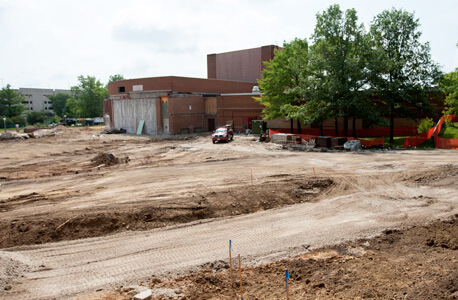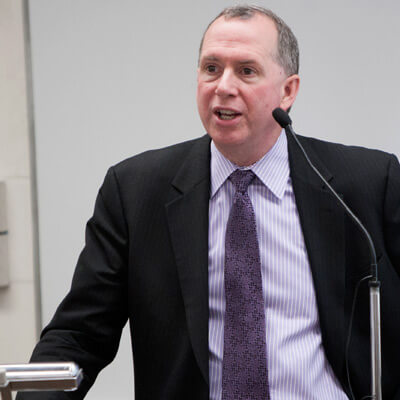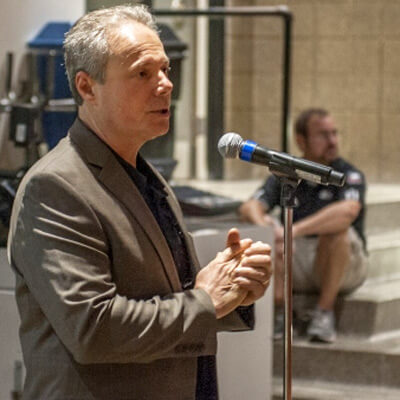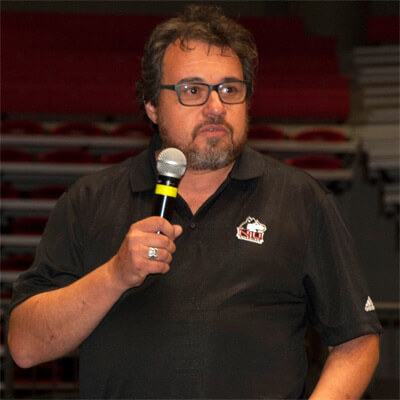NIU officials and partners will dig shovels into dirt at 11:45 a.m. Monday, Sept. 22, to commence construction of the new Stevens Building.
The groundbreaking ceremony continues the long-awaited process to turn one of NIU’s most-dilapidated buildings into a modern learning and performing space for the Department of Anthropology and the School of Theatre and Dance.
All are welcome.
Illinois Gov. Pat Quinn will attend the ceremony along with NIU dignitaries and external collaborators from the Illinois Capital Development Board, architectural firm Dewberry and River City Construction.
“What could serve as a more palpable proof of the university’s commitment to Student Career Success,” asks Alex Gelman, chair of the School of Theatre and Dance, “than advocating for and committing resources to a state-of-the-art facility in which to train students for their profession and their lives in the industry in the 21st century?”
Rehabilitating the Stevens Building, which opened in 1959, was a priority on campus for nearly two decades.
The building’s heating, cooling and ventilation systems were on the verge of failure. Plumbing and electrical systems were outdated. Portions of the roof were beyond repair. Portions of the building exterior were crumbling. Many of the classrooms, work spaces and other facilities within the structure were no longer adequate for their intended uses.
In January of 2012, Gov. Pat Quinn released $10.3 million for the Stevens Building and Cole Hall projects; Cole reopened in the fall of 2012.
Rehabilitation plans for Stevens include a new, 6,000-square-foot lecture auditorium with tiered seating for up to 330 students, state-of-the-art teaching technology and the flexibility to be divided into three smaller rooms.
Other additions including adding about 10,500 square feet to the Black Box Theatre, which will feature a 30-foot ceiling, and 13,300 square feet to the scene shop. Workers also will put on a new roof, replace the heating, ventilation and air conditioning systems and modernize the plumbing and electrical wiring.
“The opportunities the new facilities will provide for faculty to engage students in cutting-edge classrooms, labs and meeting spaces,” says Kendall Thu, chair of anthropology. “We have always been proud of our anthropology faculty, students, and program, but dreaded working in a building that was demoralizing. The very idea that we’ll have facilities that are actually inspirational represents a complete cultural transformation for us.”
For years, McCord says, the Stevens Building essentially dared students and faculty in the Anthropology Department to compensate for an old and poorly functioning physical environment.
But when the Anthropology Museum moved from its former location in Stevens to its new home in Cole Hall, that test changed.
“The new space challenges the museum to live up to the full potential that a vibrant public space affords them. And, I think we can confidently say that the museum is doing so,” McCord says.
“Once the Stevens Building is completed, the department will face a similar positive challenge,” he adds. “The new space in Stevens will invite the department to do its best work, to engage students in the laboratory and the classroom and to recruit and retain strong faculty. I’m confident they will do so.”
Holly, who joined the College of Visual and Performing Arts in 1983 as a professor of percussion in the NIU School of Music, has waited decades for this day.
He remembers when the Stevens Building made “the list” of funding priorities – and when it disappeared. Now “a great team” of people is helping to make renovation decisions that are focused on the NIU mission, including how the facility impacts students, faculty and the theater-going public.
“We are indebted to my predecessor, Harold Kafer, and former President John LaTourette for not only getting it back on the list but also for making it NIU’s top priority. We are extremely appreciative of the efforts by Gov. Quinn’s office to provide the funding,” Holly says.
Throughout he years of waiting, he watched his colleagues in the School of Theatre and Dance soldier on amid the building’s worse-for-the-wear conditions.
He’s proud to note that the school and its programs command a distinguished reputation around the world in spite of the crumbling headquarters.
“While we’ve done a tremendous job hiring nationally and internationally known faculty, the facility has limited what we’ve been able to do in terms of production value,” Holly says.
“With the completion of this renovation we will have state-of-the-art teaching, learning and performance spaces from which generations of students and audiences will benefit,” he adds. “I am most excited about the new scene shop and the new black box theater. Our faculty and students have been known for creating professional-quality productions in the previous spaces, and with these new, state-of-the-art spaces, there will be no limits to what they can accomplish.”
Gelman, who leads those faculty and students, agrees.
“Every person who works at the School of Theatre and Dance, as well as everyone who retired in the last five years, was hired with the expectation/promise that Stevens would be renovated. As the years went on, the building grew worse and more dilapidated, while the programs grew in size, scope and quality,” Gelman says. “It is thrilling to see facility begin to match the the promise and quality of the programs.”
Faculty, staff and students now are busily engaged in designing projects and directions they could not possibly have considered in the old Stevens Building, he says.
Proof of their wherewithal is demonstrated by how they’ve adapted to temporary life outside Stevens.
Mainstage Series productions, normally performed in the O’Connell Theatre or Players Theatre, are held Huntley Middle School, 1515 S. Fourth St. in DeKalb. The Studio Series, normally performed in the Corner Theatre, is now staged inside Diversions Lounge of the Holmes Student Center. Space is being rented on Route 38 for the scenery shop.
“We are dreaming of a new future and supporting these dreams with a great deal of expertise and know-how,” Gelman says. “This is, without a doubt, the dawning of a new era in theater and dance on the NIU campus. Many of the limitations that have held us back will be swept away. I can’t think of a more exciting place to be at the moment.”





